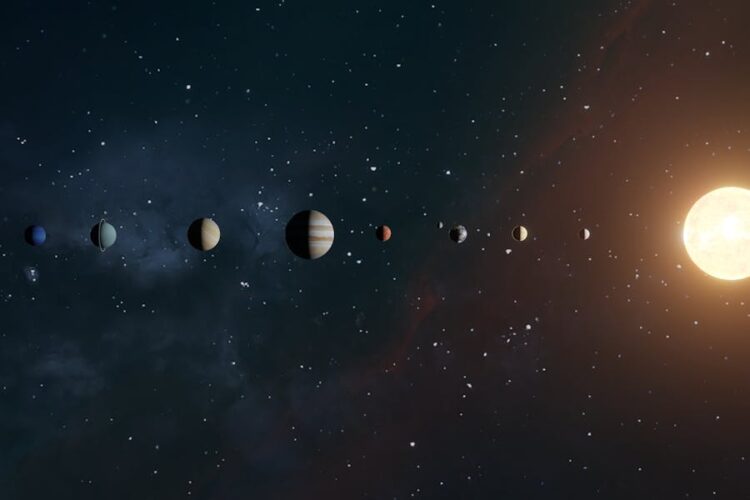The allure of the cosmos has captivated human imagination for centuries, with celestial events such as planetary alignment standing out as enigmatic marvels. Planetary alignment, the rare phenomenon where celestial bodies seemingly converge in the night sky, has been both a subject of fascination and a catalyst for scientific inquiry. In this article, we delve into the mysteries surrounding planetary alignment, exploring its definitions, mechanics, historical significance, and the quest to answer the timeless question: When will all the planets align?
When will all the planets align?
The alignment of all the planets in our solar system is an infrequent event due to the complex dynamics of their orbits. While partial alignments, such as conjunctions or oppositions, occur more frequently, the simultaneous alignment of all planets is much more infrequent. Such a perfect alignment may not happen within a single human lifetime due to the planets’ differing orbital periods and inclinations. However, astronomers and enthusiasts keep a keen eye on celestial events, utilizing advanced tools and predictive models to anticipate and observe these extraordinary alignments when they do occur.
Types Of Planetary Alignments
Planetary alignments manifest in various intriguing forms, each offering unique celestial spectacles. Here are the key types:
Conjunctions: Conjunctions occur when two or more celestial bodies appear close together in the sky as viewed from Earth. In the context of planetary alignment, this often involves planets seemingly converging along the same line of sight. Conjunctions can be superior (when a planet is on the opposite side of the Sun from Earth) or inferior (when a planet is between Earth and the Sun). These events offer breathtaking opportunities for stargazers and astronomers alike, as planets such as Venus and Jupiter can appear remarkably close to one another, creating dazzling displays in the night sky.
Oppositions: Oppositions occur when a planet is positioned directly opposite the Sun in Earth’s sky, with Earth situated between the planet and the Sun. The planet is at its closest approach to Earth during opposition, making it appear exceptionally bright and prominent. Mars, for example, exhibits spectacular oppositions roughly every two years, offering optimal viewing opportunities for astronomers to observe its surface features and phenomena, such as the Martian polar ice caps.
Grand Alignments: Grand alignments, also known as planetary configurations or planetary lineups, involve the alignment of multiple planets along a straight line. While truly perfect alignments involving all the planets in the solar system are exceedingly rare, configurations where several planets align nearby occur periodically. These alignments can be visually stunning and scientifically significant, providing opportunities for researchers to study gravitational interactions and planetary dynamics.
The Mechanics Of Planetary Alignment
The mechanics of planetary alignment are governed by the fundamental principles of celestial mechanics, including gravitational forces and the laws of planetary motion established by Johannes Kepler.
Orbital Dynamics:
Planetary alignment is fundamentally rooted in the orbits of celestial bodies around the Sun. Each planet follows its elliptical path, determined by its orbital period and eccentricity. The varying speeds at which planets orbit the Sun contribute to the rarity of perfect alignments. Additionally, the inclination of a planet’s orbit relative to Earth’s orbit affects the likelihood of alignment, as planets may appear to pass above or below each other as seen from Earth.
Gravitational Forces:
Gravity plays a central role in shaping the motions of celestial bodies and influencing their alignments. The gravitational pull exerted by each planet and the Sun influences the trajectories of neighboring planets, leading to complex interactions and occasional alignments. While gravitational forces primarily govern the orbital dynamics of celestial bodies, they also contribute to the subtle perturbations that can lead to alignments over time.
Kepler’s Laws:
Kepler’s laws of planetary motion, formulated by Johannes Kepler in the 17th century, provide a mathematical framework for understanding the motion of planets in our solar system. These laws describe the elliptical orbits, equal area law, and harmonic relationships governing planetary motion. By applying Kepler’s laws, astronomers can predict the positions of planets with remarkable accuracy, facilitating the study and observation of planetary alignments.
Factors Influencing Alignment Frequencies:
Several factors influence the frequency and likelihood of planetary alignments. Orbital periods, eccentricities, and inclinations all contribute to the complexity of planetary motions and the rarity of perfect alignments. While some alignments, such as conjunctions and oppositions, occur more frequently due to the relative positions of Earth and other planets, grand alignments involving multiple planets aligning in a straight line are much rarer and require precise conditions to occur.
Calculating Alignment Occurrences
Calculating the occurrences of planetary alignments involves intricate mathematical modeling and sophisticated astronomical software. Here’s an overview of the process:
- Orbital Parameters: Astronomers begin by collecting precise data on the orbital parameters of each planet in the solar system, including orbital periods, eccentricities, and inclinations. These parameters define the shape, size, and orientation of each planet’s orbit relative to the Sun.
- Numerical Integration: Astronomers utilize numerical integration techniques, such as numerical integration algorithms or differential equation solvers, to predict planetary positions over time. These methods simulate the gravitational interactions between planets and compute their positions at specific points in time.
- Ephemerides: Ephemerides are tables or data sets that provide the positions of celestial objects at given times. Astronomical ephemerides, generated using computational models based on orbital dynamics and gravitational forces, offer precise predictions of planetary positions for any desired date and time.
- Astronomical Software: Specialized astronomical software packages, such as JPL’s HORIZONS system or the Swiss Ephemeris, incorporate sophisticated algorithms and data sets to calculate the positions of planets and other celestial objects. These software tools allow astronomers to predict planetary alignments and other celestial events accurately.
- Iterative Analysis: Given the complexity of orbital dynamics and gravitational interactions, predicting planetary alignments often requires iterative analysis and refinement of computational models. Astronomers continuously validate and improve their models based on observational data and theoretical insights, ensuring the accuracy of their predictions.
- Observational Constraints: While computational models can accurately predict planetary alignments in theory, observational constraints, such as atmospheric conditions and light pollution, may affect the visibility of these events from Earth. Astronomers consider these factors when planning observations and interpreting computational results.
Conclusion
While the perfect alignment of all planets in our solar system remains a rare and awe-inspiring event, the study of planetary alignments offers profound insights into the dynamic interplay of celestial bodies. Through mathematical modeling, observational data, and technological advancements, astronomers continue to unravel the mysteries of planetary motion and gravitational forces. Planetary alignments serve as captivating reminders of the beauty and complexity of the cosmos, inspiring wonder and curiosity in scientists and stargazers alike.
FAQ’s
What happens during a planetary alignment?
During a planetary alignment, two or more planets appear close together in the sky as viewed from Earth. While this alignment may not have significant gravitational or physical effects, it provides an aesthetic spectacle for stargazers and astronomers.
Are planetary alignments rare?
Yes, perfect alignments where all the planets align in a straight line are rare due to the complex dynamics of planetary orbits. However, partial alignments or conjunctions between planets occur more frequently and can still be visually striking.
Do planetary alignments affect Earth?
Planetary alignments typically do not have any direct physical effects on Earth. However, they can have cultural and scientific significance, inspiring fascination and providing opportunities for astronomical observation and study.







